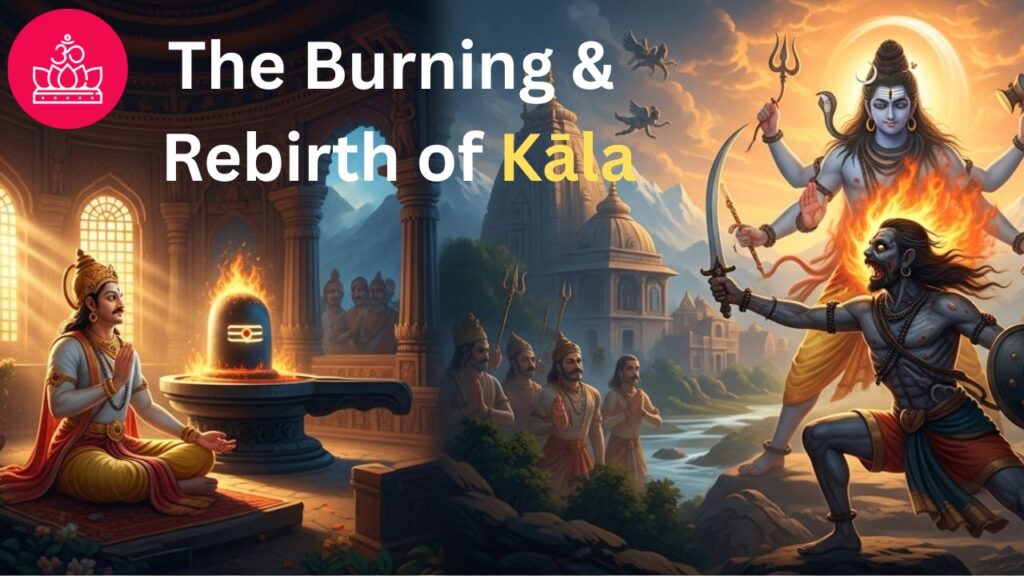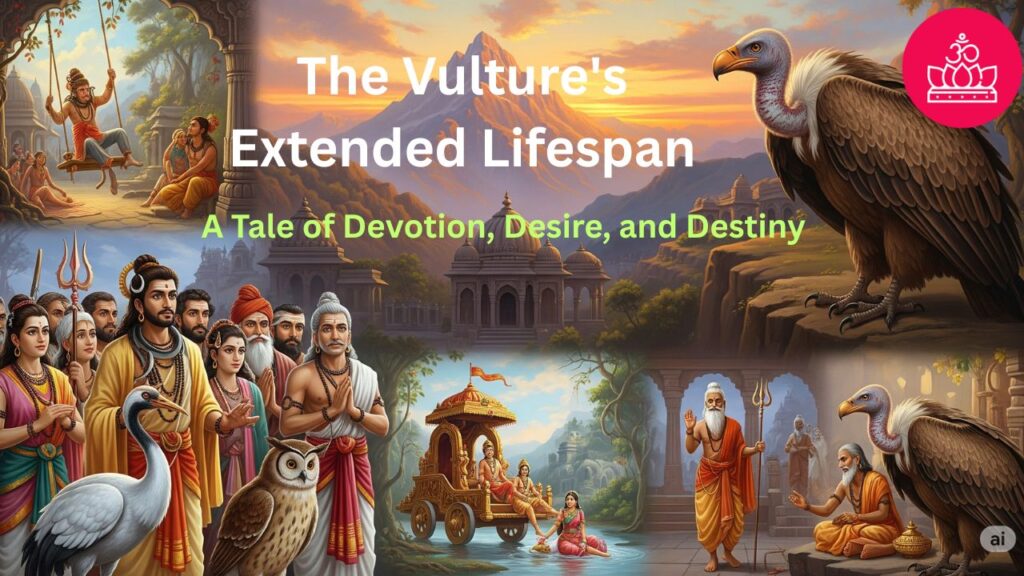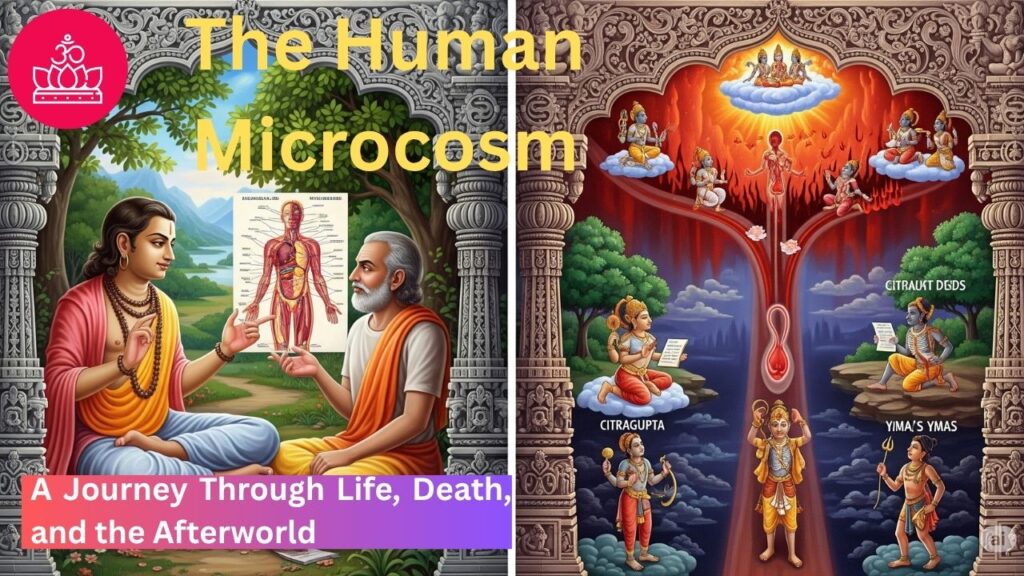The Burning and Rebirth of Kāla: A King’s Devotion and Śiva’s Grace
As told in: Skanda Purana – Kedāra-khaṇḍa of the Maheshvara-khaṇḍa – Chapter 32: The Burning of Kāla
This chapter from the Skanda Purana unveils a captivating narrative demonstrating the boundless devotion of King Śveta and the unwavering protection offered by Lord Śiva, highlighting the profound power of unwavering faith and the intricate dance between creation, destruction, and preservation within the cosmic order. The story unfolds with a clear beginning, middle, and end, showcasing the interplay of dharma, bhakti (devotion), and the ultimate triumph of righteousness.
# The Righteous Reign of King Śveta
The tale begins with the sages inquiring of Lomaśa, a revered narrator, about the extraordinary life of King Śveta. Lomaśa, a blessed soul privy to divine knowledge, readily recounts the king’s virtuous reign. Śveta, a ruler of exceptional character, dedicated his life to the worship of Lord Śiva, a devotion that permeated every aspect of his kingdom.
>“That king administered the kingdom in accordance with his capacity. With devotion, he always worshipped Śaṃbhu, the great lord, the Supreme Being, greater than the greatest, the quiescent one, the ancient lord in the form of the Supreme Spirit.”
His reign was characterized by prosperity, justice, and the flourishing of dharma. Medicinal herbs sprouted naturally, social harmony prevailed amongst the four castes, and the populace lived free from the usual afflictions of life—poverty, disease, and the untimely death of children. This idyllic state was a direct consequence of the king’s unwavering devotion to Śiva, illustrating the profound impact of a righteous ruler’s piety on his kingdom. This paints a vivid picture of a utopian society, a testament to the transformative power of dharma and the blessings it bestows.
# The Intervention of Yama and Kāla
This blissful existence, however, was threatened. Yama, the god of death, dispatched his messengers to claim King Śveta’s life. However, Śveta, deeply absorbed in meditation within a Śiva temple, remained untouched by their attempts. This highlights the impenetrable shield of divine protection granted to those steadfast in their devotion. This inability to claim the king’s life infuriated Yama, who, in turn, summoned Kāla, the personification of time and destruction.
Kāla questioned Yama:
>“Why was this great king not taken away by you, O Dharmarāja? O Yama, (though) you are assisted by your messengers, you appear to me to be frightened. Do not delay, O deity of good holy rites. At my instance do everything quickly).”,
However upon realizing that Yama and his attendants couldn’t to their job fearing the wrath of Śiva, Kāla himself undertood that mission in his hands.
Kāla, a fearsome figure described as possessing a terrifying form and wielding a sharp sword and shield, stormed into the temple, intent on fulfilling Yama’s command. This sets the stage for the climactic confrontation. The description of Kāla is vividly terrifying, emphasizing the immense power of the force of destruction.
# Śiva’s Intervention and the Burning of Kāla
Witnessing Kāla’s malicious intent towards his devoted servant, Lord Śiva intervened. The description of Śiva’s reaction is powerful, emphasizing his role as protector of his devotees:
>‘This (deity) is desirous of killing my devotee, the excellent king Śveta. He is absorbed in his own soul by way of meditation. His mind has become purified by the bright light of pure knowledge.’
With a single glance from his third eye, Śiva reduced Kāla to ashes. The celestial beings, witnessing this act of divine intervention, were awestruck. The scene is painted with vibrant details, showcasing the grandeur of the cosmic realm and the awe-inspiring power of Śiva.
>“The groups of Devas who had gathered together along with Yakṣas, Gandharvas, Piśācas, Guhyakas, Siddhas, groups of celestial damsels, all the sky-walkers, serpents, birds and the Guardians of Quarters, saw Kāla enveloped in flames and stationed in front of Īśvara.”
King Śveta, emerging from his meditation, was initially bewildered by the spectacle. Upon learning of Śiva’s action, he questioned the reason behind the destruction of Kāla. This exchange reveals the king’s compassion and his understanding of the cosmic balance.
# The King’s Plea and Kāla’s Rebirth
Śiva explained that Kāla, the devourer of all beings, was a threat to Śveta’s life. However, Śveta, demonstrating his profound wisdom and understanding of dharma, pleaded for Kāla’s revival. He recognized Kāla’s essential role in the cosmic cycle, acknowledging both its destructive and creative aspects.
>“Indeed Kāla is the annihilator of all mobile and immobile beings. Similarly, he is the matchless protector too (of all). He is the creator as well of the vital air of all living beings. Hence revive him back to life.”
Touched by Śveta’s compassion, Śiva resurrected Kāla. This act underscores the significance of compassion and understanding even in the face of seemingly insurmountable forces.
# Kāla’s Repentance and New Mandate
Reborn and humbled, Kāla offered fervent prayers to Śiva, expressing remorse and acknowledging the Lord’s supremacy. He then received a new mandate from Śiva, instructing him to spare those devoted to Śiva, regardless of their past actions.
>“The following persons should never be brought to my region: Those who apply Tripuṇḍra (upon their forehead); those who have matted hair; those who wear Rudrākṣa; those who are called by the names of Śiva…They should be scrupulously avoided even if they are always sinful.”
This emphasizes the transformative power of devotion and the ultimate protection afforded to those who embrace Śiva’s path.
# The Liberation of King Śveta
The chapter concludes with the liberation of King Śveta, who, having attained the highest form of devotion, merged with Śiva, achieving Sayujya. This emphasizes the ultimate goal of bhakti yoga—union with the divine.
>“On being honoured by Devas, sages and Serpents, this Śveta, the most excellent one among kings, attained Sāyujya (identity) with Śiva.”
The story concludes with a powerful message about the power of devotion, highlighting the importance of dharma, the interconnectedness of creation and destruction, and the ultimate triumph of righteousness. It is a testament to the unwavering protection offered by Lord Śiva to his true devotees and the profound impact of a righteous life.



